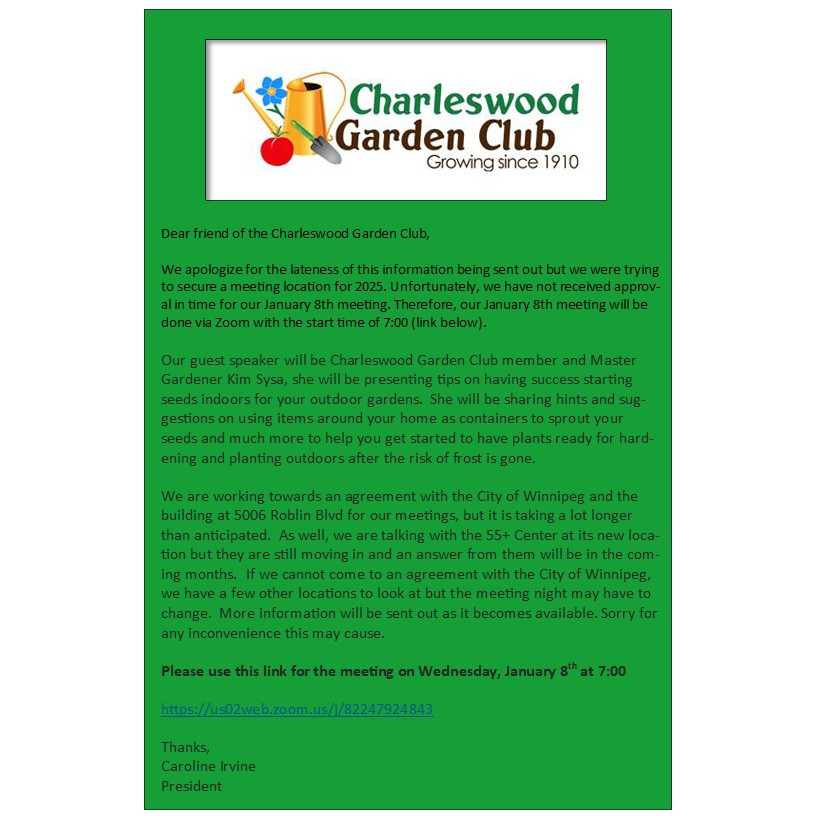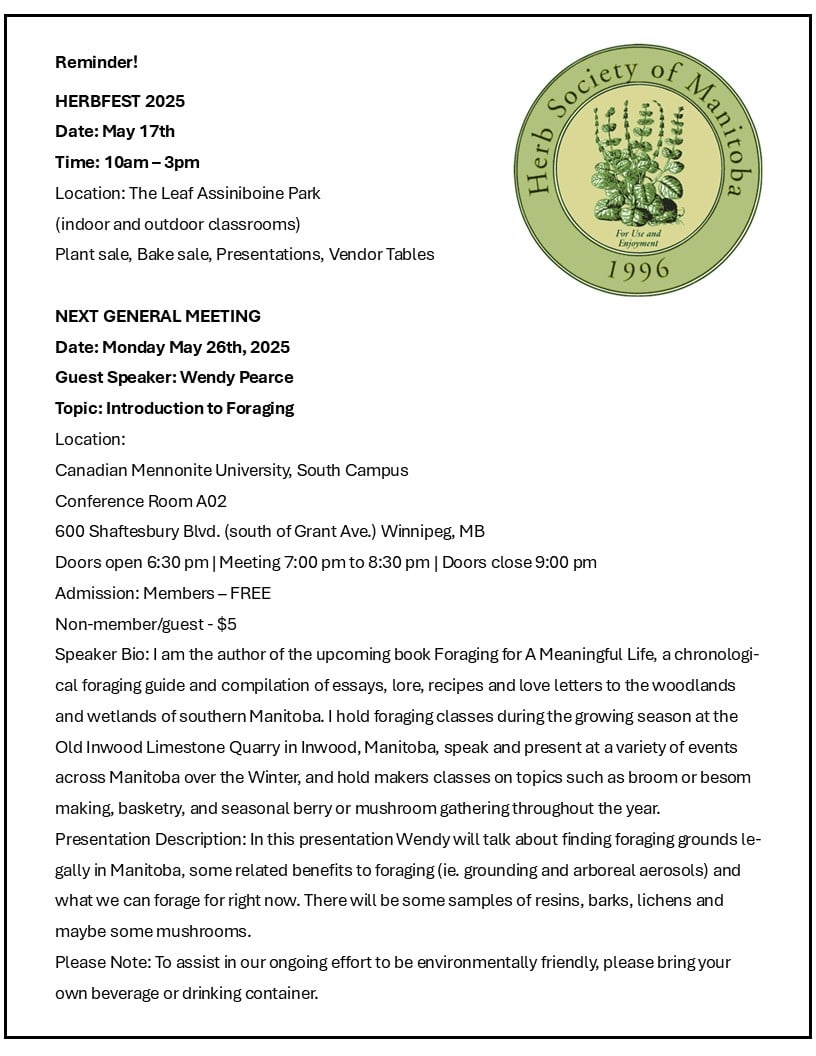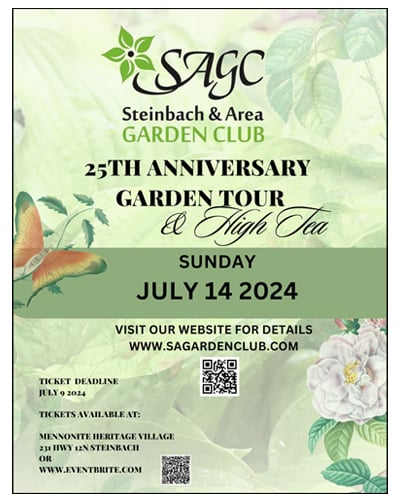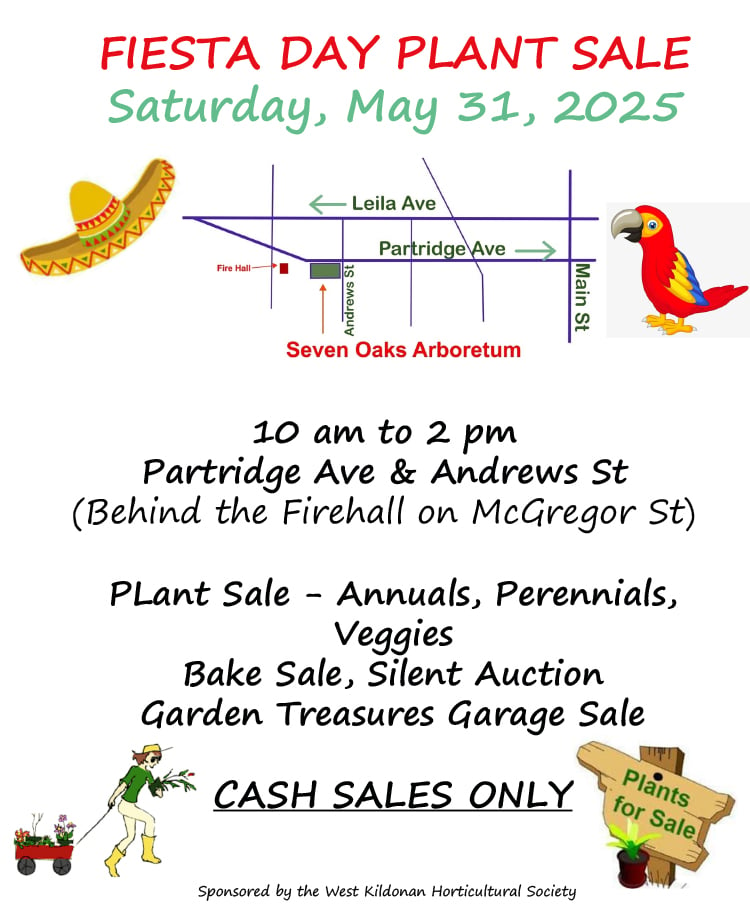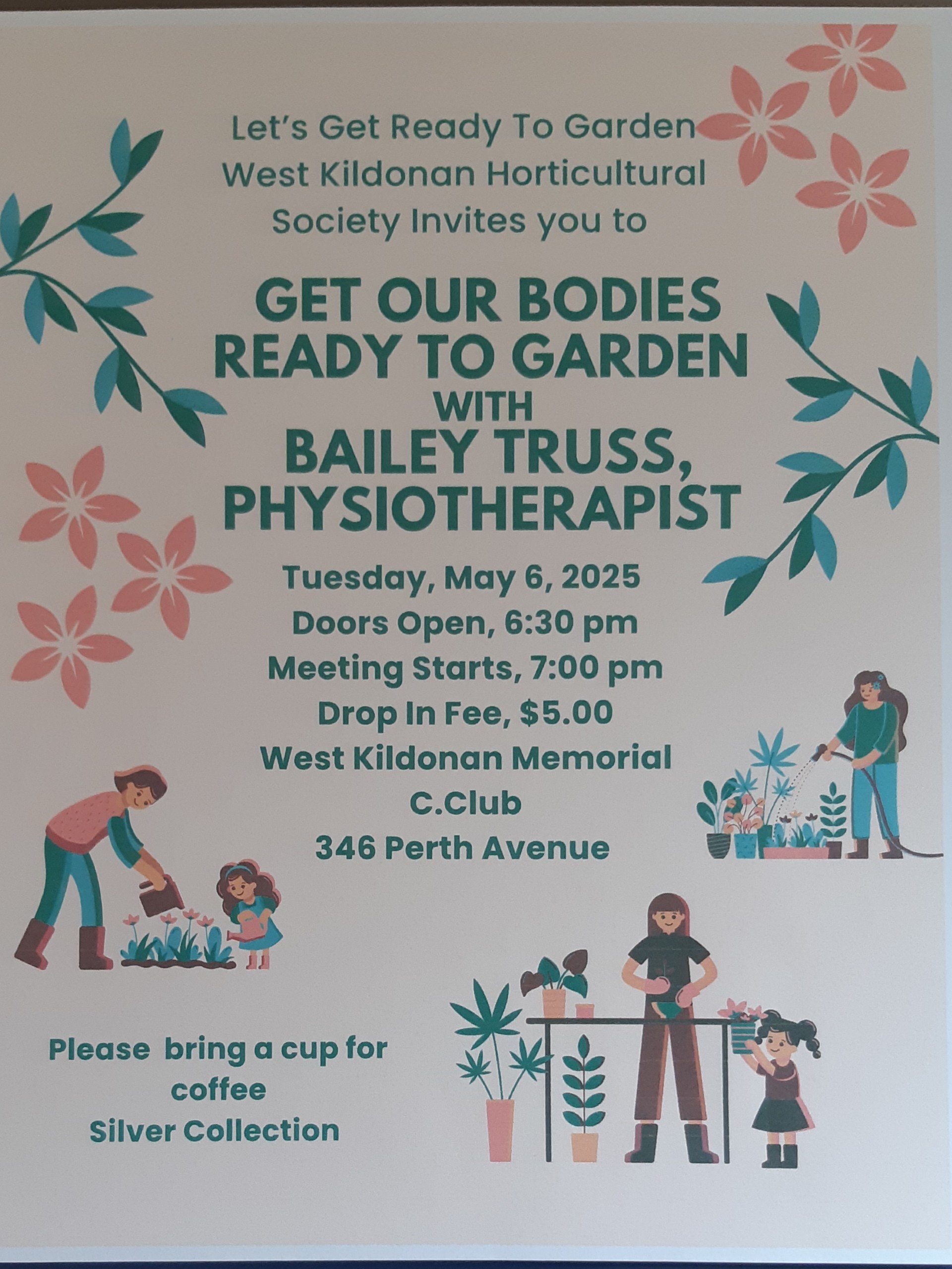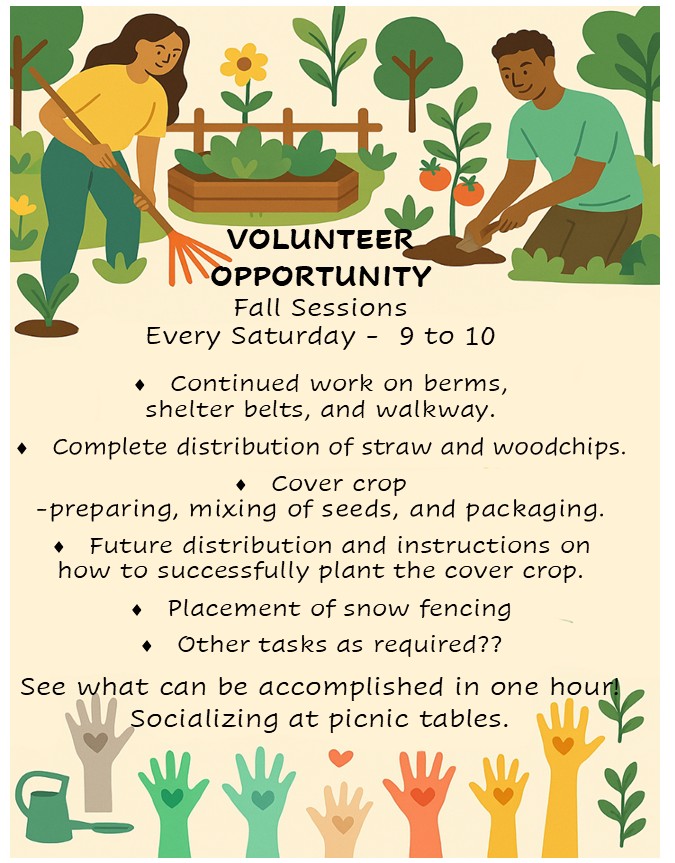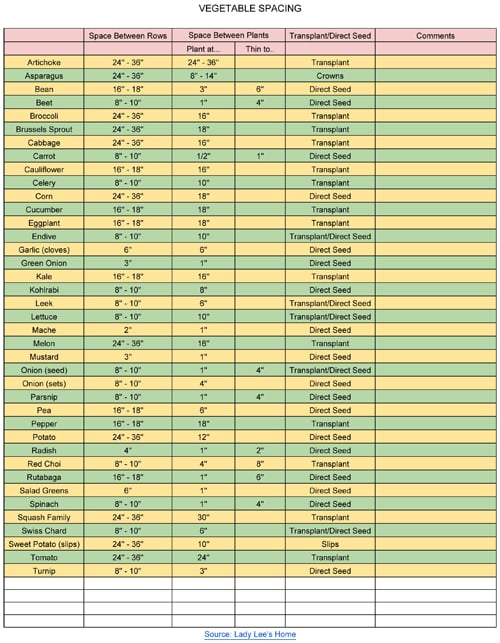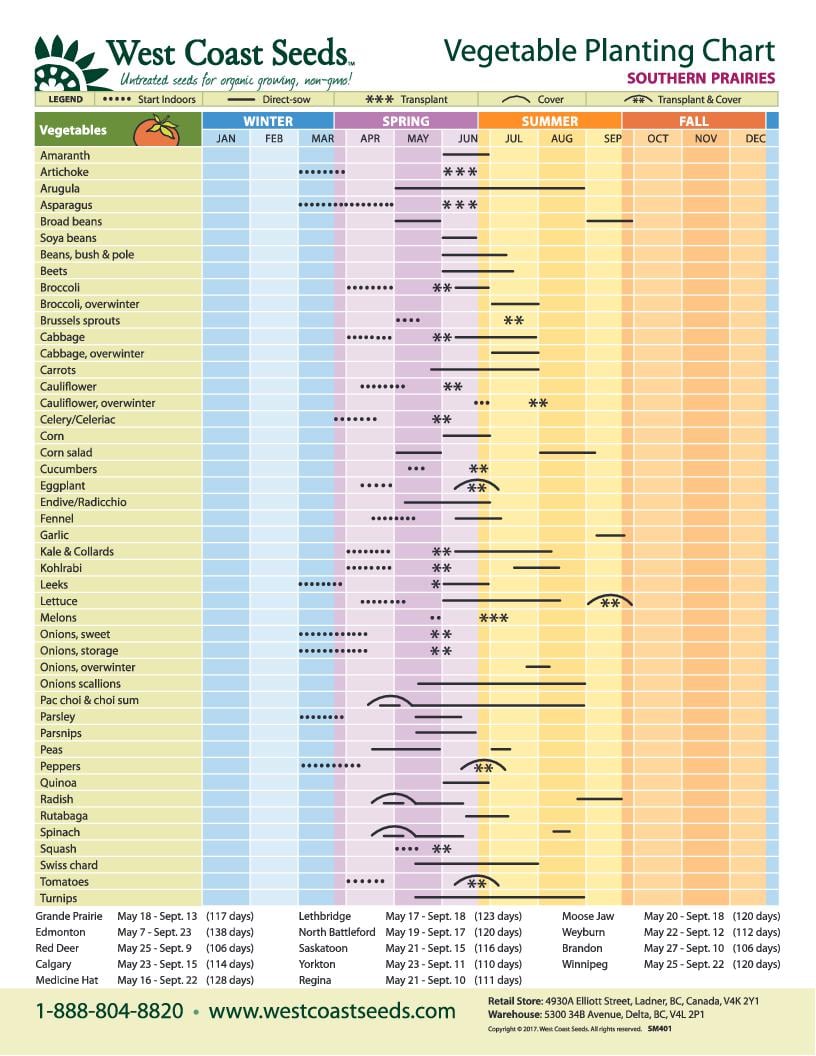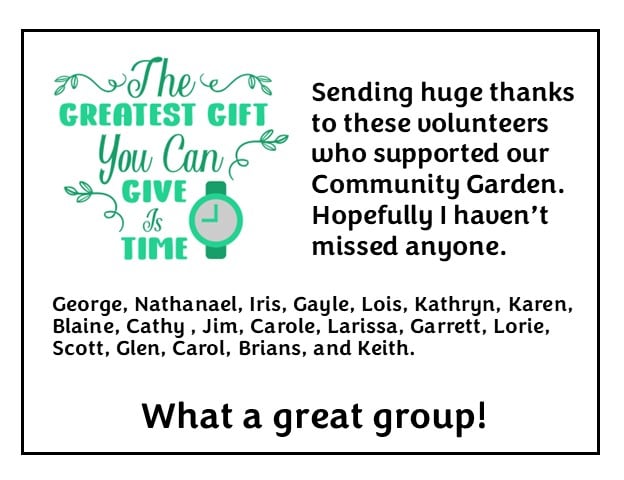
CONTACT US
Email:  stjameshort@gmail.com
stjameshort@gmail.com
SJHS Website: ( stjameshorticulturalsociety.ca)
stjameshorticulturalsociety.ca)
– please visit if you would like to sign up for our newsletter
Facebook: St. James Horticultural Society
Instagram: st_james_horticultural_society
Address: St. James Horticultural Society
Box 54027
2533 Portage Ave
Winnipeg, MB R3J 0L5


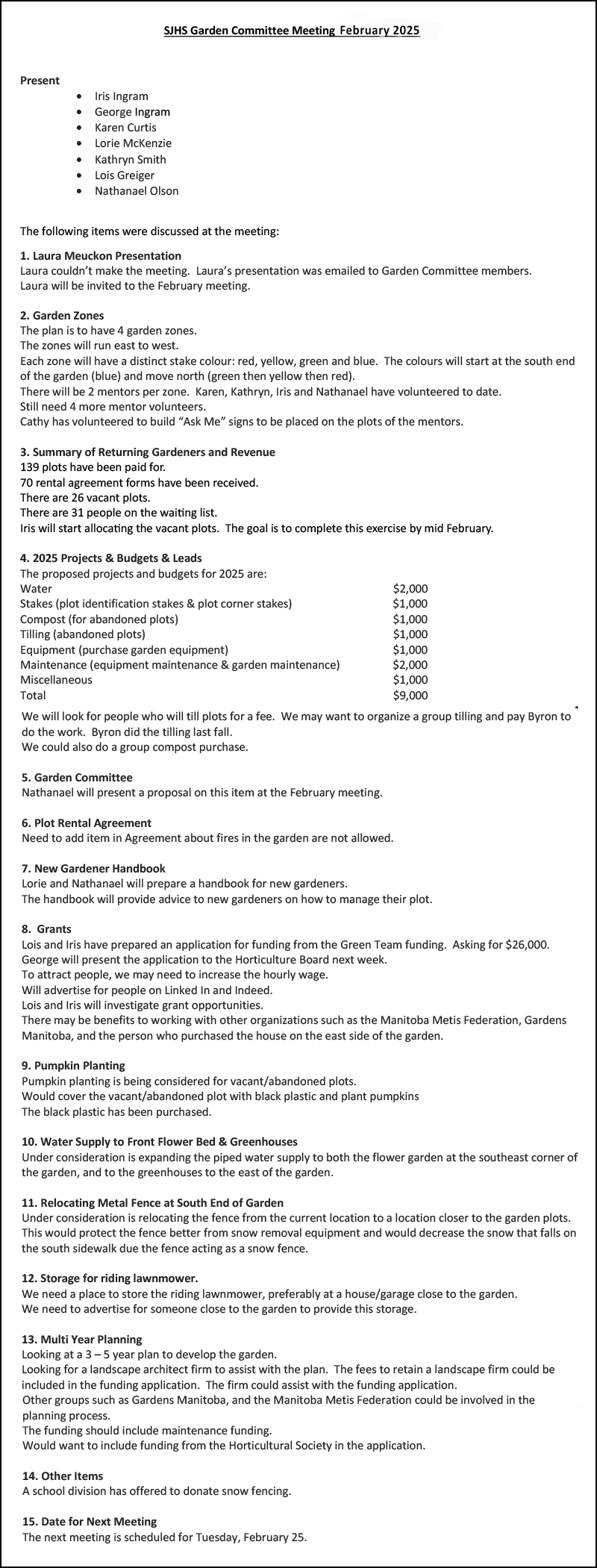
GARDEN FEES INCREASE
Gardeners:
Due to considerable amounts of rain in June, resulting in quack grass and 100 plots being abandoned, rototilling repair costs for these abandoned plots, with the anticipations of more tilling in the spring of 2025 and the transitioning from tilling to a no-till system, we have been forced to increase the Garden Plot fees.
The St James Horticultural Society, acting on advice from the Garden Committee, has authorized an increase in plot rental fees to $50.00 per plot for the 2025 gardening year. Also, new gardeners will be required to make a $60.00 per plot damage deposit for the 2025 gardening year. These increases are needed to cover the increased costs of operating and maintaining the garden. Garden costs in 2024 increased substantially due to costs incurred remediating plots that were abandoned and/or managed in an unacceptable manner by gardeners.”
Garden Committee
Co-Chairs Nathanael and George
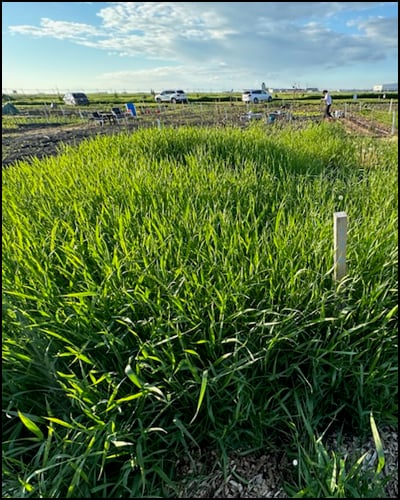
1. Weed and Quack Grass Management
Time to remove quack grass. How?
Dig out roots and remove them.
Hoe out grass before 4 leaves grow.
Dig out pathways.
Till every time 4 leaves appear. Cover with double cardboard and leaves or hay or straw. Maintain a consistent routine to prevent regrowth by monitoring and treating
the area regularly.
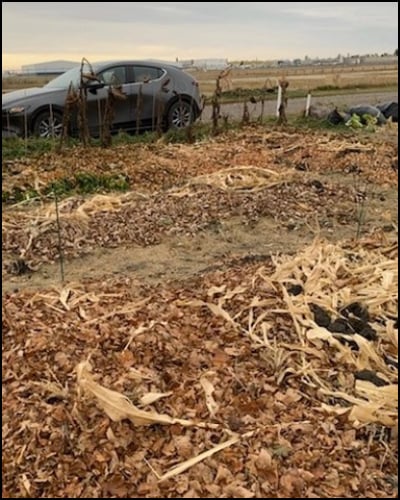
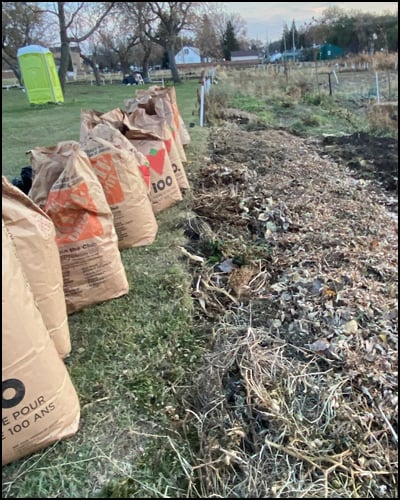
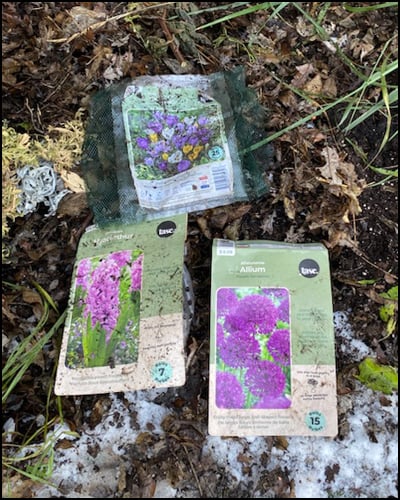

4. Wood Chips on pathways
To add fungus to our gardens we have wood chip pathways. The fungus feeds our soil and plants.
Pathways prevent water from flowing and eroding.
Pathways will help you get to your garden next April.
Actually the grass. Our garden has a quack grass infestation and this year was a grass-growing year.
2. Feeding your soil
Chop all your plants and leave them in your garden.
Make a compost pile for next spring.
Buy compost or soil and incorporate it into your garden.
Bring leaves and grass and spread them on your garden.
This year out of 226 garden plots 103 have been neglected or abandoned.
The result is disheartening to the 123 of us who worked our gardens with great effort due to too much rain in the early season.
As a volunteer group, we had to decide what to do.
After contacting every one of the plot owners we cut the grass and we are now tilling. Please move everything that you have brought into your plot including tarps, plastic, tools, bricks, patio stones, wood, wagons, barrels, buckets, and tomato cages to make tilling accessible. Tilling is not a great solution as it chops roots and could lead to more grass, however, given that the grass practically took over we have no choice.
We are asking gardeners and volunteers to pick out roots and we will till again in about a week.
We then will ask gardeners to add organics such as grass clippings, leaves, or compost.
This is all volunteer work and paid for tilling. We ask everyone to help with Project Plot Rehab this fall.

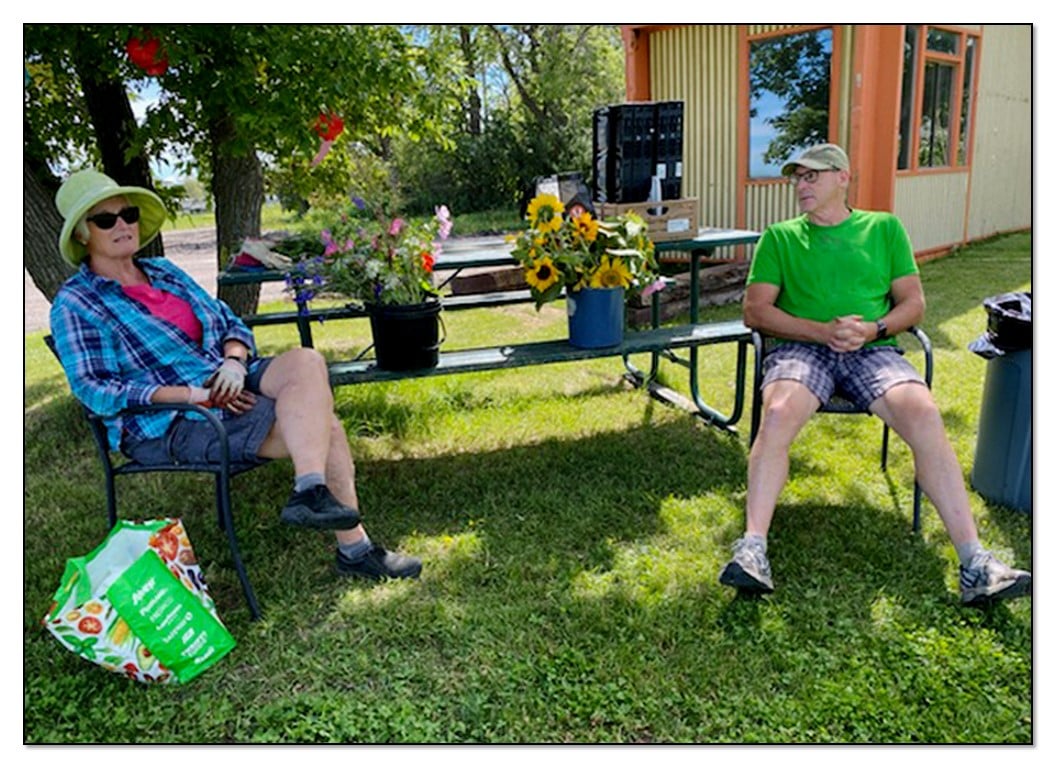
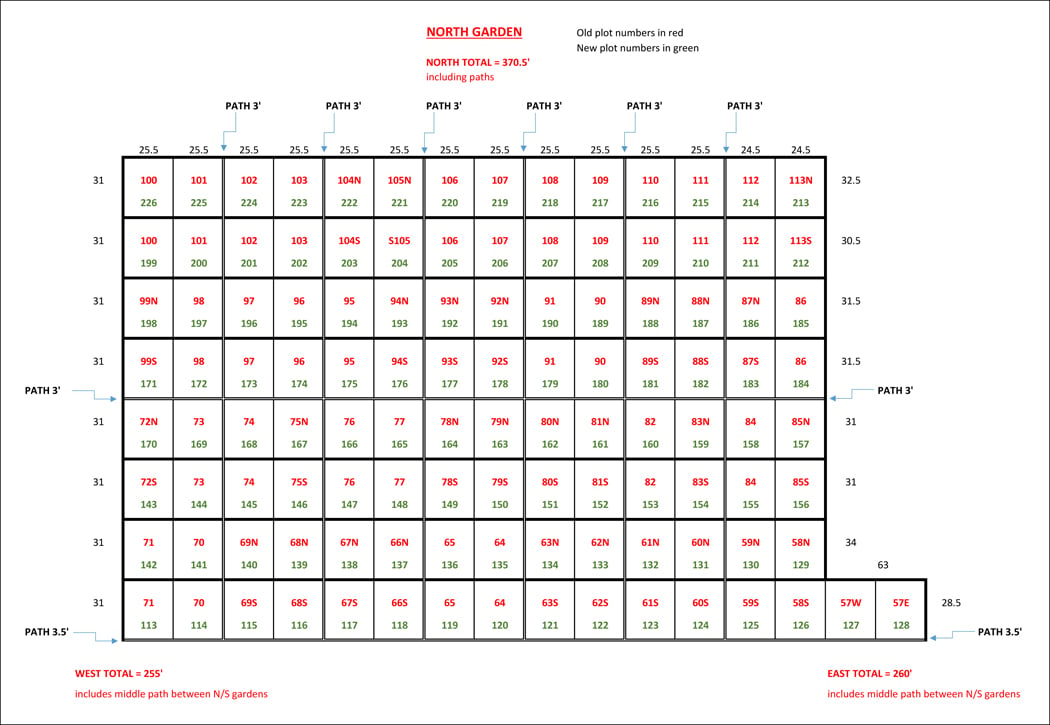
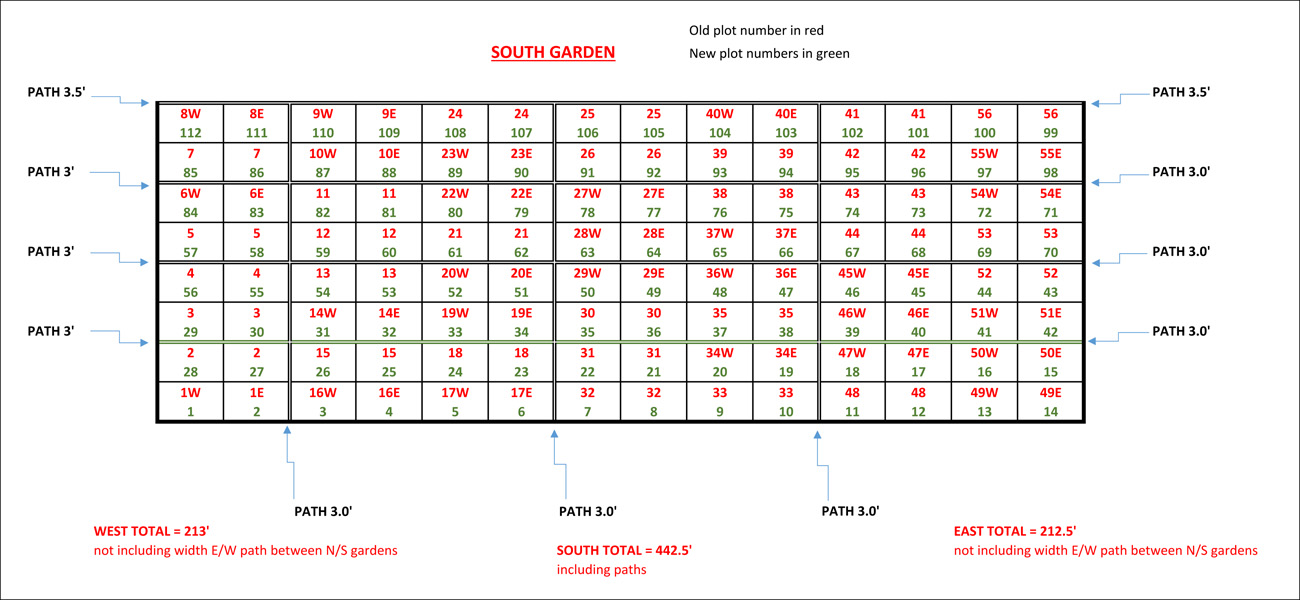
NOVEMBER
A good night to be out and about, without a snowflake in sight.
Tonight's Demo was called Christmas, a door swag using all things Christmassy demonstrated by Bev.
Our Workshop was called Birthday, a fan shape arrangement incorporating small balloons and/or streamers (Trimmed).
Until next month.
Stay warm as we get ready for the white stuff.
Sharon
Workshop in November: Birthday
A fan shape arrangement incorporating small balloons and/or streamers (trimmed)
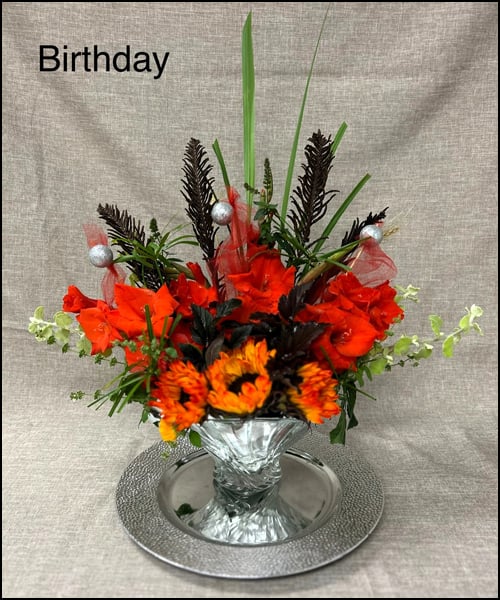
Demo: Christmas
A door swag using all things Christmassy - demo by Bev
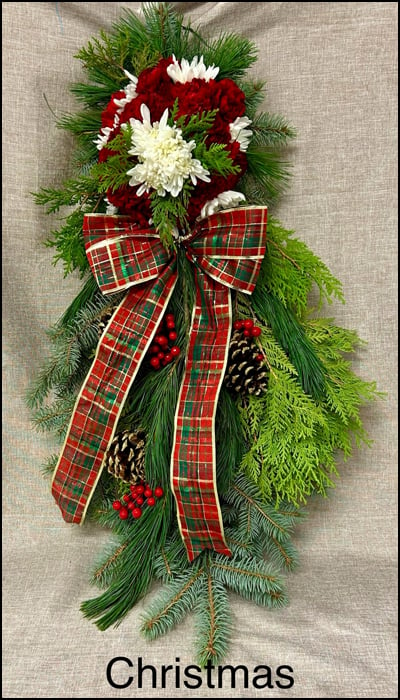
SEE SLIDE SHOW OF ADDITIONAL IMAGES
IN OUR FLOWER ARRANGING GALLERY
VVV
V
 FLOWER ARRANGING GROUP (stjameshorticulturalsociety.ca)
FLOWER ARRANGING GROUP (stjameshorticulturalsociety.ca)
A Heartfelt Thank You to Louise May
On April 15th, 2025, we had the pleasure of welcoming Louise May, herbalist and founder of Aurora Farm, to Crestview United Church for her engaging workshop, "Hands-on Herbs."
From the moment she began, Louise captivated the audience with her passion, knowledge, and warmth. Her interactive approach—allowing attendees to touch, smell, and truly experience the herbs—created an immersive and unforgettable evening. The enthusiasm in the room was undeniable, as participants eagerly explored the world of herbs and gained a deeper appreciation for their uses and benefits.
Her life story, rooted in a love for gardening and a commitment to sustainable agriculture, resonated deeply with the audience. Many left not only inspired by her teachings but also with a newfound curiosity and admiration for the way she connects people to the land.
We extend our sincere gratitude to Louise May for sharing her wisdom and creating such a memorable experience. Her dedication to education and herbal traditions made this event truly special.
Thank you, Louise, for an enriching and inspiring evening!

On behalf of the St. James Horticultural Society, we would like to extend our heartfelt thanks to Martha Barwinsky, for the exceptional presentation she delivered on “Trees” on March 18, 2025, at Crestview United Church. The event was well attended, and the lively question-and-answer session showcased the audience's keen interest in her expertise and passion for urban forestry.
Her insights into Winnipeg’s tree canopy, her work with the Comprehensive Urban Forest Strategy, and her dedication to initiatives like the Coalition to Save the Elms and Trees Winnipeg were truly inspiring. It’s clear that her decades of experience, combined with her enthusiasm and commitment to the community, have made a significant impact.
We are grateful for the opportunity to learn from her and appreciate the time and effort she took to share her knowledge with us. Her presentation has deepened our appreciation for the trees around us and the vital role they play in our urban environment. We look forward to staying connected and supporting her efforts to protect and expand Winnipeg’s urban forest.

Heartfelt Thanks for Your Engaging Presentation on Insect Pests
Dear Ian Wise,
On behalf of the St. James Horticultural Society, I would like to extend our deepest gratitude for your engaging and informative presentation on the intricate world of insect pests. Your insights and expertise in pest management and entomology were both enlightening and inspiring.
Thank you for sharing your extensive gardening experience and providing us with valuable insights and practical knowledge of insect pests. We hope to have the pleasure of welcoming you again in the future.
Warm regards,
St. James Horticultural Society

Thank You, Kelly Leask!
We would like to extend a heartfelt thank you to Kelly Leask, owner of Prairie Originals, for her captivating presentation on “Planting a Butterfly Garden” at our meeting on January 21, 2025, at Crestview United Church.
Kelly's expertise and enthusiasm for native plants were truly inspiring. As a dedicated gardening educator, Master Composter, seed saver, and co-founder of the Winnipeg Wildflower Project, Kelly shared invaluable insights and practical tips on creating beautiful butterfly gardens that support local ecosystems.
We are grateful for Kelly's contribution and her commitment to promoting native plants. Her knowledge and passion have left a lasting impact on all of us.
Thank you, Kelly, for an enlightening and enjoyable session!
https://www.prairieoriginals.com
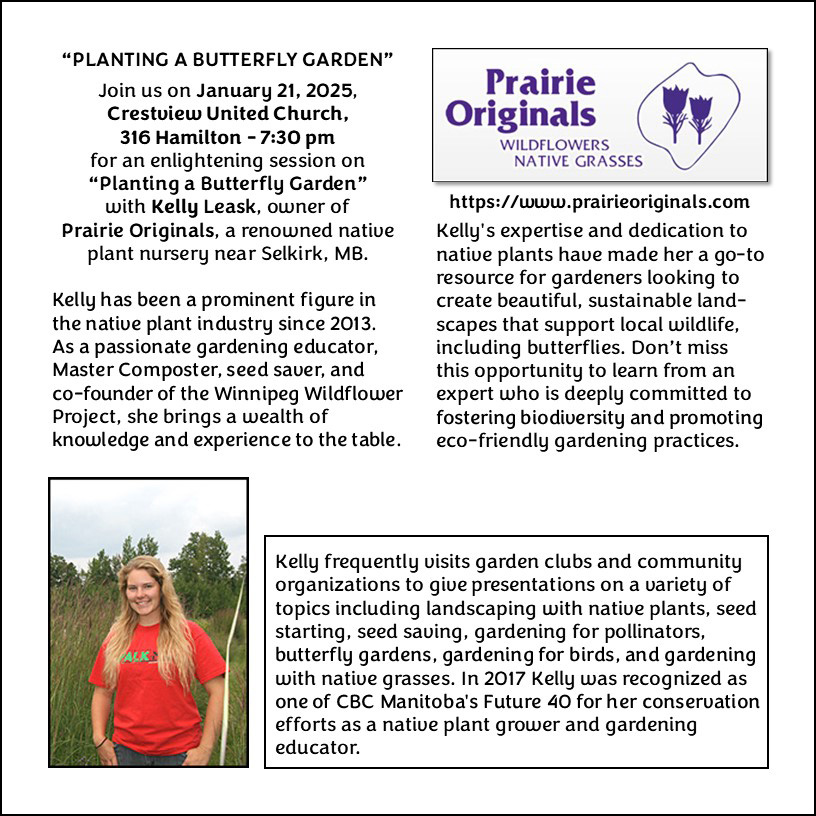

2023 AGM
The Annual General Meeting was held on November 21st at 7:00 pm at our new Meeting Venue at CRESTVIEW UNITED CHURCH, located at 316 Hamilton Ave.
Presidents Report AGM 2022/23
It was another interesting year! The SJHS welcomed 2 new board members and with a team of volunteers worked to provide programming for general meetings, flower arrangers, grant writing, the building of pollinator and perennial gardens , preparing the gardens for the season and working on special projects. Always with the goal of sustainability in our minds.
I would like to introduce our board of volunteers that coordinated the various activities of the SJHS this year: Gayle Leverton as President, Jennifer Anderson as Past President, Iris Ingram as First Vice President, Kathryn Smith as Interim Second Vice President, Natalie Turner as Secretary, Val Carter as Treasurer, George Ingram as chair of the Garden , Sandy Venton as chair of Programming, Leah Stawiarski as chair of Membership, Linda Rudachek as chair of Communication, Pat Roberts as chair of Flower Arranging and Kathryn Smith as Interim Hospitality chair. Kathryn Smith took on the position of
(Interim) 2nd Vice President in March of 2023 after the resignation of Al Robinson.
We would like to Thank Al Robinson for his contribution to the Board before moving to Campbell River.
Thank you to the volunteers that have served on the garden committee and others who have contributed time and energy, financial donations and goods in kind, (including plants), to the numerous garden projects this year. We wouldn’t have an organization without you. We are all volunteers. Thank You!
General meetings took place during the months of January, February, March, April and October. Subjects included, “Planting a Pollinator Garden”, by Lois Grieger, “Composting “by Lori Graham, “Factors to consider in No Till & Low Till Gardening by Ted McLachlan and Rod Kueneman, “Mushroom Gardening”, by Tom Nagy, and “House Plants”, by Lori Graham.
We raised $375.01 from our annual Glenlea Plant Sale in the spring and we thank everyone who volunteered to coordinate the sale and to all who purchased plants.
We had a different start to the gardening year as our entire garden was not tilled. Some gardeners chose to till while others used different creative techniques to work the soil. Compost and wood chips were provided to help with this purpose. The garden was “alive” with exchanges of ideas and possibilities.
We had 2 Pot Luck dinners at the garden site this year. One was in July and the other in September. They were well attended and included a Flower Arranging demonstration and tours of the Shelter Belt, Pollinator Garden and the Discovery Daycare’s Pumpkin Patch.
Once again, we partnered with the Leftovers Foundation to donate excess garden produce to an organization in our neighbourhood, Turning Leaf Support Services, and also with Community Foodshare, supporting folks in St James with limited access to food. This year we started a Sharing Table set up beside the Shed, where gardeners left extra produce for others. This new endeavour was very popular.
We received two grants this year; a Nature Manitoba-Native Habitat grant for $2000.00 which provided funds for our Pollinator Garden and another from the Manitoba Community Development Green Team for $2,393.81, that allowed us to hire Lena Podolsky to help with taking care of the grounds around the gardens.
SJHS did not have an exhibition due to concerns; about the cost of running one, having enough volunteers and not having enough attendees. We did collaborate with the St Vital Agricultural Fair and unfortunately were disappointed in the SJHS response with both volunteers and participants. The board has decided to suspend the Exhibition until there is enough interest and volunteer capacity to put one on. Gardener’s interests seem to be changing more toward food security.
The Flower Arrangers met the 1st Wednesday of every month except for July, August and January. They had 9 members this year. Monthly meetings were held at Adrian Sala’s office. The meetings consisted of floral demonstrations followed by a workshop where members make an arrangement following themes from the previous month. The Theme of this year was focused on Books and many creative arrangements were made.
Thank you for your support as members of the St. James Horticultural Society!
Sincerely,
Gayle Leverton
President
St. James Horticultural Society
We want to extend our heartfelt thanks to Marika Olynyk for her excellent presentation on Invasive Species. Even though the attendance was modest, her delivery and insights captivated the few of us who were present.
Her expertise and engaging style sparked meaningful discussions and left us with much to think about. The value she brought to the session was immense, and I am confident that the participants deeply appreciated her presentation.
We had considered at the meeting the possibility of arranging a field trip to the Living Prairie Museum for members of the St. James Horticultural Society. Members, please let us know if that would be of interest.
Thank you once again, Marika, for your time and effort. We look forward to any future opportunities to hear you speak.
Anyone wanting a PDF of Marika's presentation please send request via email to stjameshort@gmail.com to receive a copy. Also please note the resource information below. Thank you for your interest and support.
Invasive Species Synopsis
Marika Olynyk – Living Prairie Museum
Living Prairie Museum is a nature park that protects tall grass prairie. This ecosystem once covered most of south-central Manitoba, but now less than 1% remains. At Living Prairie Museum, along with providing educational opportunities for the public, we care for our remaining prairie. Our preserve has over 150 known plant species and a lot of our time is spent managing invasive species in order to protect this diversity.
To understand invasive species, we need to define our terms:
· Native/Indigenous Species: Indigenous or occurring naturally in a given geographic locale (not introduced by humans).
o Co-evolved with the other species in that area, and have natural limits to their spread.
o In Winnipeg and southern Manitoba, are part of mainly tall grass prairie ecosystems, as well as wetland, oak/aspen forests, and riverbank forests.
· Introduced Species: A species or organism which arrives and establishes as a result of human activities. Introduction can be accidental or deliberate.
o Evolved in different area with different set of ecosystem relationships.
o Introduction has always occurred but has increased with global trade and increased human movement. Not all introduced species are harmful.
o Some examples: ornamental plants, dandelion, honeybees, and many food crops.
· Invasive Species: Invasive alien species are animals, plants or other organisms that are introduced by humans, either intentionally or accidentally, into places outside of their natural range, negatively impacting native biodiversity, ecosystem services or human economy and well-being.
o Whether a species becomes invasive depends on how it interacts with the place it is introduced to.
o Some examples in Manitoba: Canada/creeping thistle, leafy spurge, caragana bush, purple loosestrife, burdock, and Kentucky bluegrass.
· Weed: An agriculturally, economically or horticulturally undesirable species.
o Some “weeds” are introduced, some are invasive, some are native.
o The invasive species listed above are all often considered weeds. Some other examples: strawberry blite and common milkweed (both native species) and sow thistle, dandelion and creeping bellflower (introduced species).
Impacts of invasive species can be economic (crop losses, costs of weed control, reduced ecosystem services), human health (disease and disease spreaders), ecological (loss of diversity, reduced resilience of ecosystems, threats to rare/at-risk species, changes to food webs). At Living Prairie Museum, we are very concerned with the ecological effects, which include removing flowering plants that pollinators need, replacing deep-rooted prairie plants with invasives that don’t hold water or carbon as well, and altering the entire food webs of our native prairie. Invasive species are extremely difficult to control/remove once established! Invasive plants tend to grow very densely and crowd out other plants quickly.
Some people don’t worry about invasive species. Many introduced plants are used by humans and other living things, so one person’s weed is another person’s medicine. As examples, St. John’s wort, plantain, burdock all have medicinal or edible qualities that people enjoy. However, we need to look at the implications and effects for all living things to decide how to best contribute to caring for the Earth. Short-term gain from an invasive might result in long-term harm on the broader scale. Invasive species are considered one of the top five threats to nature, and it is one that we can directly help prevent.
Recommendations for your gardens: PREVENTION is the most important thing so start with native plants whenever possible (these have the bonus of being adapted to our soils and moisture). Choose a less invasive alternative to invasive plants, and if you aren’t sure if something is invasive, look it up! There are lots of good resources online, including Manitoba Master Gardeners, Ontario Invasive Plants Council, and Minnesota Department of Natural Resources.
Garden plants to reconsider:
• Ox-eye Daisy
• Tartarian Honeysuckle
• Caragana
• Dame’s rocket
• Himalayan balsam
• Purple loosestrife
• Russian olive
• St. John’s wort
• Sweet Clover
• Bird’s Foot Trefoil
Invasive Species Resources
The Manitoba Horticultural Association Garden Party
The event kicked off with a warm welcome, followed by an insightful presentation by John Morgan, who explored the benefits of integrating native Manitoba plants into home and rural landscapes. Attendees appreciated his expertise on how these plants support biodiversity and enhance local ecosystems.
After a refreshing Break Thyme and vendor visits, the lunch program featured the presentation of the A.P. Stevenson Commemorative Award to Rick Durand, a respected nurseryman, forester, and one of the prairie’s leading plant breeders and tree researchers. Rick captivated the crowd with his knowledge of horticulture and sustainable practices.
The afternoon offered a diverse selection of presentations tailored to different interests. Gord Bone’s session on landscape construction inspired DIY gardeners, while Igor Kaftan’s exploration of the Coleus Craze sparked excitement about propagating these vibrant beauties. Later, attendees chose between Shea Doherty’s presentation on an exciting mystery topic or Laverne Wojciechowski’s fascinating deep dive into growing giant plants—a favorite among those eager to push the limits of horticultural ambition!
The final presentation by Colleen Zacharias opened new possibilities for home gardens, leaving everyone with fresh ideas and innovative strategies to enhance their green spaces.
The day wrapped up with the Party Finale, including prize draws of the ever-popular fan-favorite sweet pea auction and a heartfelt thank-you to everyone who made this event possible.
With plenty of learning, laughter, and garden inspiration, this year’s MHA Garden Party was truly a celebration of Manitoba’s vibrant gardening community. We can’t wait for next year’s gathering!
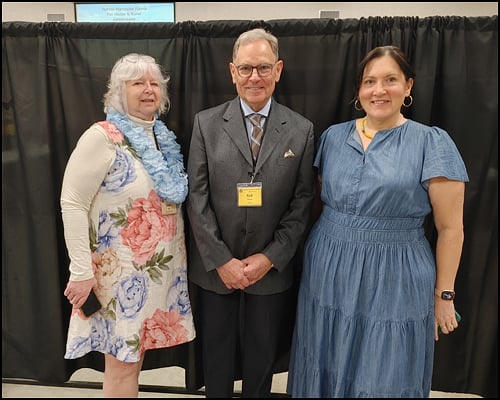
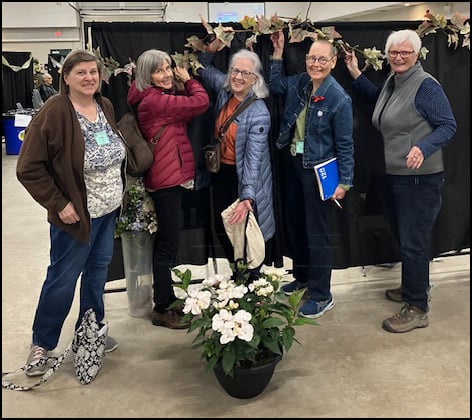
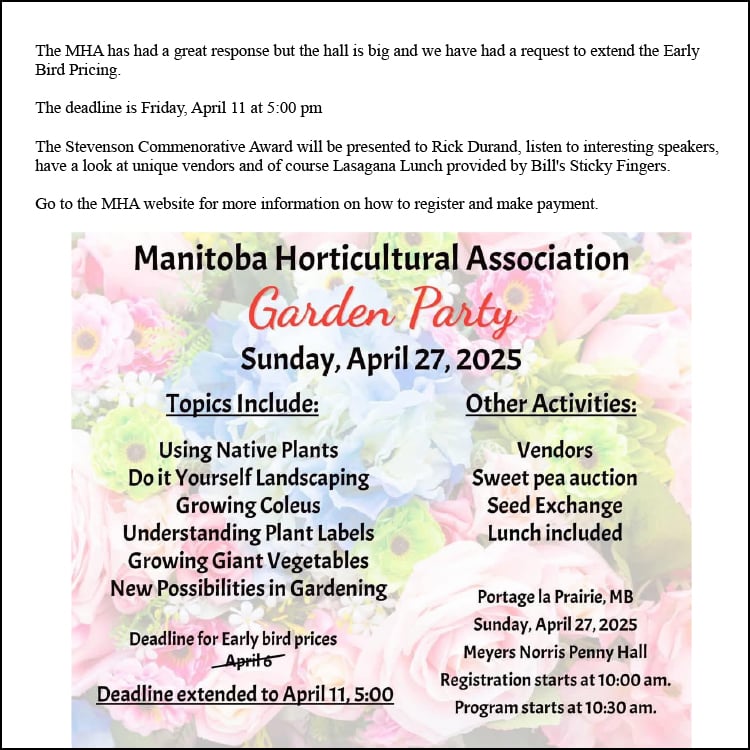
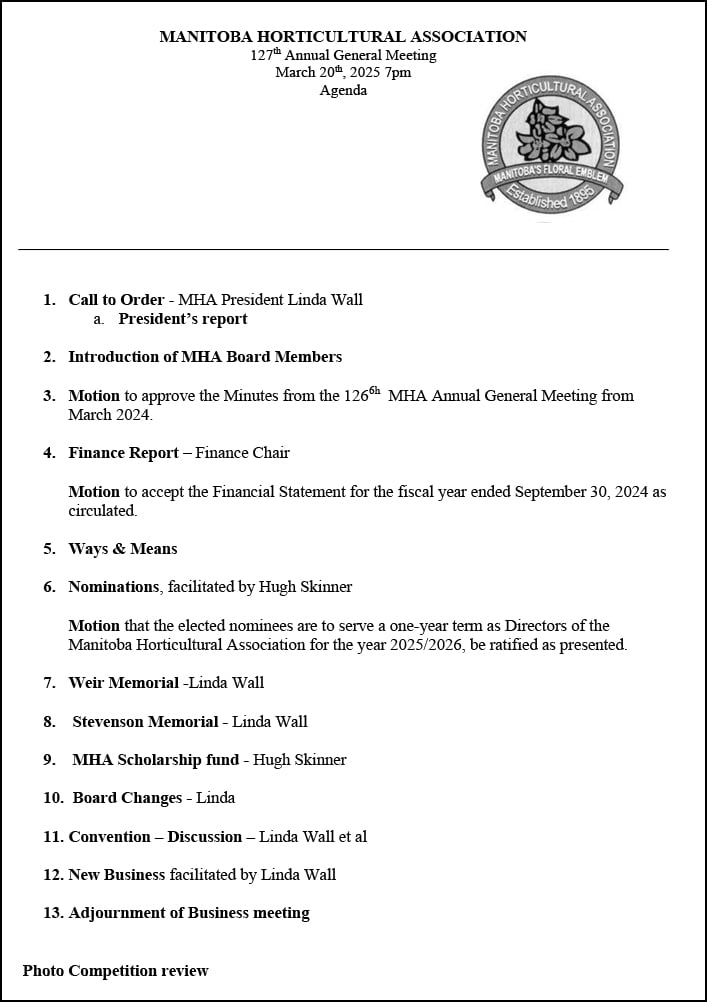
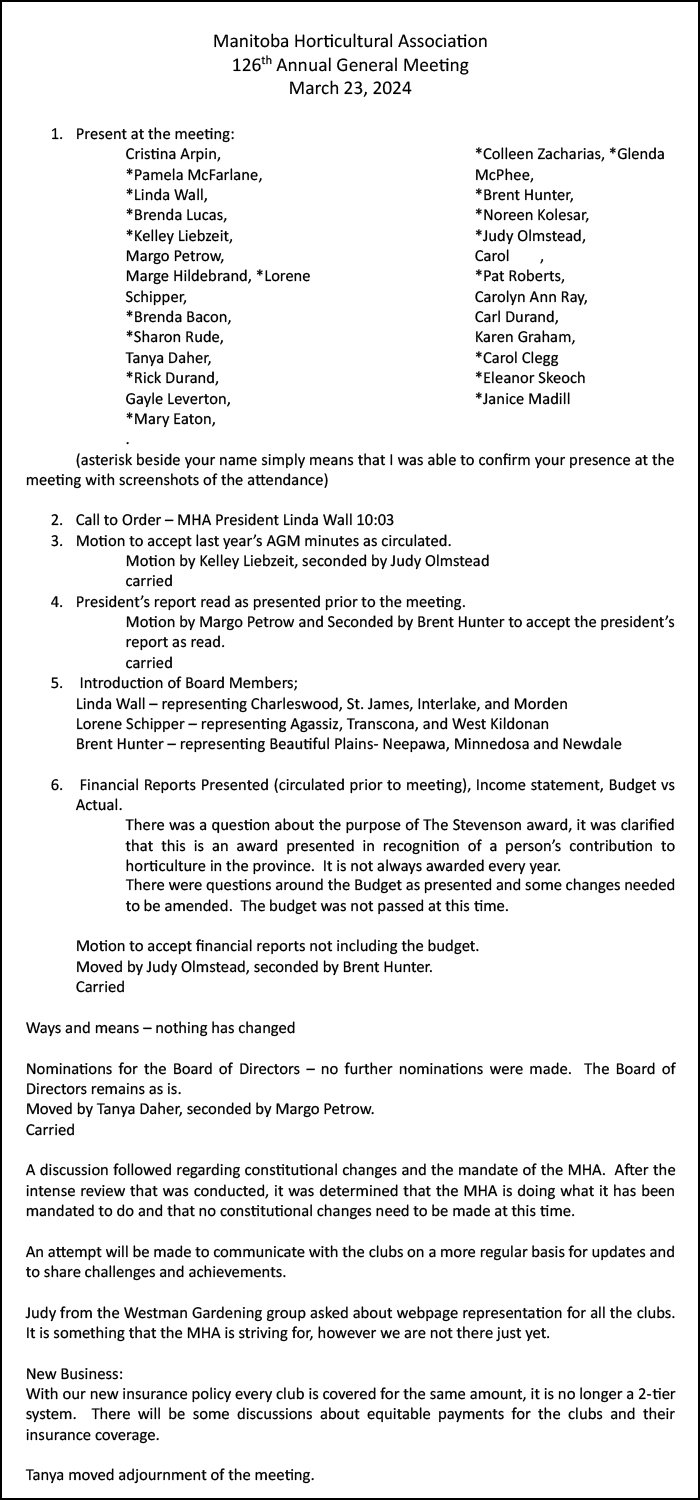



"Wilding" was released in 2023 at the BFI London Film Festival. Directed by David Allen and based on the 2018 book by Isabella Tree, the 75-minute British documentary film is an account of the rewilding project by Charlie Burrell and Isabella Tree at Knepp Wildland in West Sussex. The viewing of the film in Winnipeg, Manitoba is presented by the Manitoba Master Gardener Association and promoted in conjunction with Nature Manitoba. The film's trailer may be viewed online at  www.wildingmovie.com.
www.wildingmovie.com.
Tickets for the general public are available online at  mgmanitoba.com
mgmanitoba.com
Tickets for MMGA members are available online at  https://www.mgmanitoba.com/member-login/
https://www.mgmanitoba.com/member-login/

Dear Garden Clubs and Societies of Manitoba,
January is a great time to start something new - like training to become a Manitoba Master Gardener!
All training courses are delivered online through the University of Saskatchewan. You can take them anywhere, anytime, and have a full five years to complete them. Total cost for all 10 courses (64 hours) is only $1005, and once you have registered for the Manitoba course HORT01B, you'll get a free two-year membership in the Manitoba Master Gardener Association. You can do your volunteer practicum in your own community.
To learn the steps to certification, please read the info on our website under "MG Program", especially  mgmanitoba.com/mg-program/mgcertification/. At
mgmanitoba.com/mg-program/mgcertification/. At  mgmanitoba.com/mg-program , you'll even find a video and an info sheet with FAQs. If you still have questions, feel free to email me.
mgmanitoba.com/mg-program , you'll even find a video and an info sheet with FAQs. If you still have questions, feel free to email me.
I would love to welcome you into Manitoba's Master Gardener community.
Linda Dietrick
Training advisor
Manitoba Master Gardener Association



St. Vital Agricultural Society's Annual Display and Fair 2023
There was much to appreciate at the St. Vital Agricultural Society's Annual Display and Fair. Along with the many categories of judged entries, the exhibits and displays, the demonstrations, and the varied vendors, there was no shortage of things to do and see. Congratulations to our own Lois Ross on her success at the flower arranging competition. Compliments go to the SVAS for a spectacular annual display and fair.
The SJHS / LPM Connection
by Lois Grieger
Without the fine work of the SJHS and notably Peter de Wet - the Living Prairie Museum site at 2795 Ness Ave. might have been paved over. The efforts of SJHS in collaboration with the International Biological Program worked to secure protected status for the Tallgrass Prairie at Living Prairie Museum (1968-1976).
Members of SJHS worked with Dr Jennifer Walker (botanist from U of MB) to survey the site and develop the data to persuade St James City Council (yes this was before Unicity) to set the area aside as a nature preserve rather than build the proposed housing development. Former SJHS president Pete de Wet made an impassioned presentation before the council to preserve this rare habitat for posterity. Mr. de Wet stressed that this sliver of the prairie was the least we could leave our grandchildren. Over his long life, he must have seen some profound changes. I’m not sure how much prairie there was in 1909 when he arrived in Winnipeg from South Africa. But Mr. Wet and members of the SJHS felt it was important enough to work hard to save it. The Free Press reports the motion passed by a single vote (1971) and the first action taken by the City Naturalists was a to burn the prairie. There was outrage and a lack of understanding that tallgrass prairie ecology depends on fire and other disturbances. From the photo below it appears a fragile Mr. de Wet then 93, was at Major Juba’s side at the Living Prairie’s grand opening in 1976. Mr. De Wet passed two years later, and I like to think that the Living Prairie accomplishment capped off his gardening life. Fern mentioned she recalls Mr. de Wet. She told me when SJHS used to rotate meetings at members’ homes and Mr. De Wet looked out her kitchen window only to report he identified at least 15 different trees and shrubs. Sounds like a gardener’s gardener to me.
Given Winnipeg’s current challenges and the greater challenges presented by the climate crisis I like to tap into SJHS history to recall how through our history we SJHS members have worked in our small corner to benefit our community. And if it is true what one of my hort professor like to remind us that - “The first law of ecology is how everything is connected to everything else”, then our ecological efforts at the Silver Garden – whether it is our soil conservation efforts, planting a wind break, or planting a pollinator garden are part of SJHS’s long history of working to help connect us to everything.
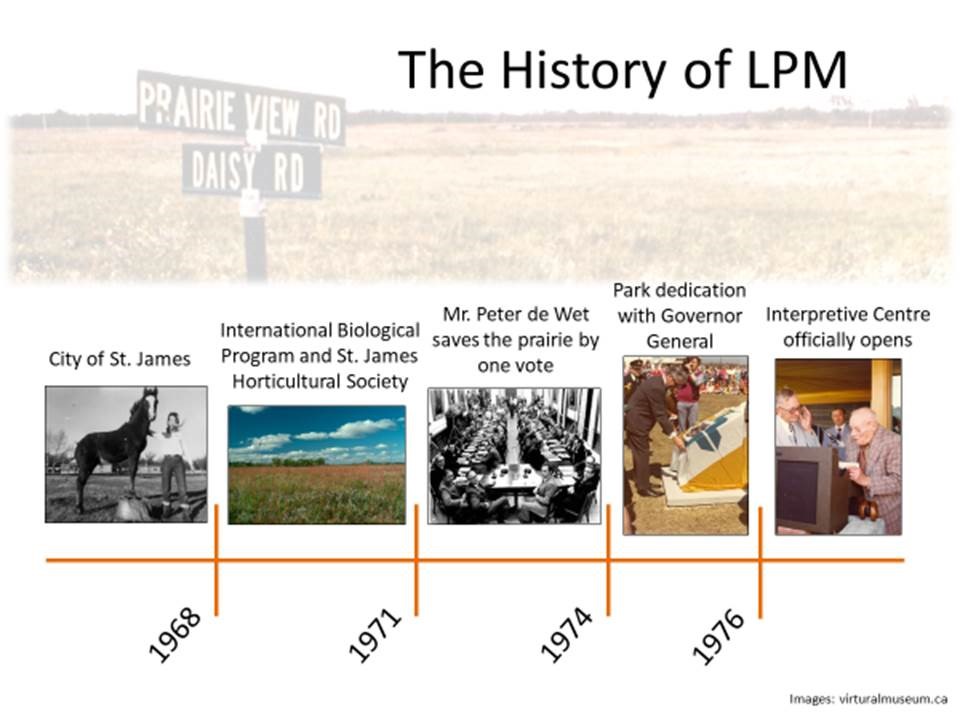
Jacobus Petrus “Pete” de Wet (1883-1978)
Journalist, horticulturist, community activist.
Born at Cape Town, South Africa on 3 February 1883, he came to  Winnipeg in May 1909. During the First World War, he served in France with the 90th Winnipeg Rifles. After his return from military service, he worked as a reporter for the
Winnipeg in May 1909. During the First World War, he served in France with the 90th Winnipeg Rifles. After his return from military service, he worked as a reporter for the  Winnipeg Free Press and provincial correspondent for the Canadian Mining Journal. He was Secretary of the Manitoba Chamber of Mines and editor of its journal, The Precambrian. During the Second World War, he served with the St. John Ambulance Brigade in Winnipeg. He held honourary life memberships in the Canadian Institute of Mining and Metallurgy,
Winnipeg Free Press and provincial correspondent for the Canadian Mining Journal. He was Secretary of the Manitoba Chamber of Mines and editor of its journal, The Precambrian. During the Second World War, he served with the St. John Ambulance Brigade in Winnipeg. He held honourary life memberships in the Canadian Institute of Mining and Metallurgy,  Manitoba Horticultural Association, and St. James Horticultural Society, and was a member of the
Manitoba Horticultural Association, and St. James Horticultural Society, and was a member of the  Canukeena Club,
Canukeena Club,  Winnipeg Horticultural Society (President, 1957), Manitoba Association of Prospectors and Developers, and Manitoba Progressive Association. He died at the
Winnipeg Horticultural Society (President, 1957), Manitoba Association of Prospectors and Developers, and Manitoba Progressive Association. He died at the  Deer Lodge Hospital on 27 August 1978.
Deer Lodge Hospital on 27 August 1978.
Restoring Truro Creek
One Pulled Thistle at a Time
by Kathryn Smith
This past summer I spent about 30 hours pulling thistle along the banks of Truro Creek. I worked on the area adjacent to Wightman Green at the corner of Linwood and Ness. Wightman Green is the park I adopted 3 years ago. By adopting a park you can help take care of it in a variety of ways. I chose to establish 3 beds of native perennials. I sourced these from plants growing in my own garden. One of them being Swamp Milkweed. While it is a beautiful and hardy plant, it is not particularly drought tolerant therefore not best suited for the middle of the park. I contacted Rod Penner, the City Naturalist. He agreed they would be suitable for naturalizing on the creek bank. His associate dug 12 holes and I planted and watered. They were large transplants and thrived. That very summer they were covered in Monarch caterpillars.
By the next summer,2022,with the help of adequate rainfall, the park gardens were well established. I turned my sights on the ugly thistle patches that border the park and the creek. It didn’t make sense to cultivate a lovely garden and leave invasive thistle next to it. Ironically named Canada Thistle , it is not indigenous to Canada but introduced from Europe hundreds of years ago. It is invasive and crowds out native species that provide a better food source for pollinators and birds. I again contacted Rod and a plan was made to pull the thistle then replant with native species. The thistle should be pulled for 3 years to weaken it enough that the new plants stand a chance. It is best to start pulling early July when it starts to bud.
Wearing a thick pair of gloves and long sleeves, I chose a shady spot to begin my labor. To my surprise , thistle pulls out quite easily using a two handed tug. Of course you don’t get all the roots , that’s why it must be pulled for three years. Every pull weakens it a little more. I found it strangely satisfying yanking at the bristle stems watching the pile of dead thistle grow. Until my back told me that was enough for the day. One day some one from Parks and Open spaces showed up with a couple of young volunteers from the Boys and Girls Club. They worked hard and cleared a lot of thistle , returning later to truck it away.
After clearing thistle from the park edges, I moved further along the creek working on it until mid September. Except for one small area I cleared the creek bed of thistle between Linwood and Winchester. A small area relative to the length of the creek but that is what one person can do. I imagine great progress if a few others pitched in , for even a few hours. I felt I had contributed to the improvement and enhancement of the creek bank habitat. Once the new planting goes in it will become a habitat where, butterflies and birds will thrive and it makes the walk by the park so much more enjoyable.
I never realized that the public could work so closely with the City. That we could have such an important role to play in the state of our green spaces. A better way to live and enjoy your community is by being active in the improvement rather than to complain about the lack of maintenance. If you would to help in the effort to restore Truro Creek to a healthy natural state please feel free to pitch in and pull. It would be wonderful to have more people involved as there is so much that could be accomplished. You can contact myself, Kathryn, through the St. James Horticultural Society at  stjameshort@gmail.com or come to the next General Meeting Feb.21. and talk to me. I am the Hospitality Person so I’ll be hanging out by the coffee urn.
stjameshort@gmail.com or come to the next General Meeting Feb.21. and talk to me. I am the Hospitality Person so I’ll be hanging out by the coffee urn.
APPLICATION / RENEWAL FORM
INTERESTED IN BEING A MEMBER OF SJHS?
Membership Application below (fillable form)
Send to: stjameshort@gmail.com
| |
ABOUT US
The ST. JAMES HORTICULTURAL SOCIETY provides occasions for interested individuals to compare notes and share information through its programs. We look forward to seeing you at our monthly meetings.
We endeavour to make our meetings interesting and would appreciate suggestions for future meetings.
If you are interested in horticulture and would like to be part of our program, please contact the Program Chairperson.
General meetings of the ST. JAMES HORTICULTURAL SOCIETY are held the 3rd Tuesday in the months of October, November, January, February, March and April at 7:30 p.m. General Meetings of the ST. JAMES HORTICULTURAL SOCIETY are held the 3rd Tuesday in the months of October, November, January, February, March and April at 7:30 p.m. at Crestview United Church, 316 Hamilton.
Most meetings showcase a speaker presenting relevant topics of interest to society members.
Parking is available in the church parking lot. Please enter through the side door.
Coffee, tea and dainties are served. We welcome any donations of dainties or cheese etc. for our coffee/snack table.
The FLOWER ARRANGING GROUP meet at 7:30 pm the first Wednesday in the months of September, October, November and December, February, March, April, May and June at the office of Adrien Sala, MLA.
The St. James Horticultural Society, the second oldest horticultural society in Manitoba, was organized in November, 1914 by 13 St. James Gardeners. This was the year of the outbreak of the First World War when the call went out that all should supply their own individual needs with Victory Gardens and many plots were put under cultivation during the war years.
In November 1929, the Society applied to the Manitoba Government for a Certificate of Organization under the Manitoba Horticultural Societies Act, and received Certificate No. 8, dated December 1, 1929.
Around 1938, the St. James municipal council allowed the Society the use of a tract of land in the north part of the city which was divided into parcels of 30 feet by 60 feet for annual competition by members. This tract has been under cultivation right up to the present time.

